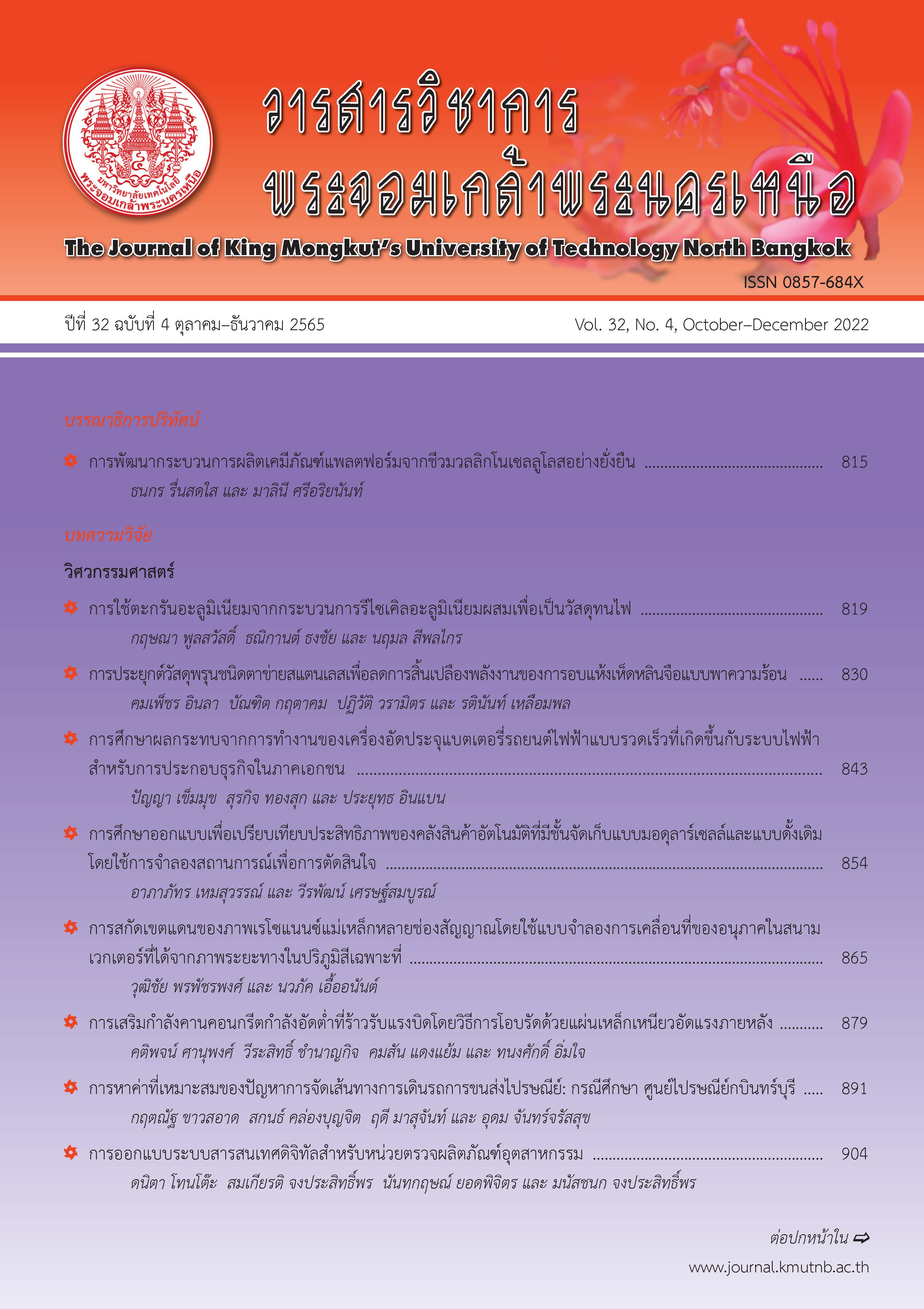การออกแบบระบบสารสนเทศดิจิทัลสำหรับหน่วยตรวจผลิตภัณฑ์อุตสาหกรรม
Main Article Content
บทคัดย่อ
แนวคิดอุตสาหกรรม 4.0 เป็นรูปแบบของการจัดการทางภาคอุตสาหกรรมที่ประยุกต์ใช้ขั้นก้าวหน้าของเทคโนโลยีสารสนเทศ เพื่อเพิ่มประสิทธิภาพในการบริหารจัดการและเพิ่มโอกาสทางธุรกิจ งานวิจัยนี้มุ่งเน้นการพัฒนาระบบสารสนเทศยุคดิจิตอลของธุรกิจอุตสาหกรรมบริการ เทคโนโลยีคลาวด์ได้ถูกพัฒนาเพื่อเป็นระบบจัดการภาระงานภายในองค์กร การออกแบบมุ่งเน้นไปที่ความต้องการของผู้ใช้งานเป็นสำคัญโดยหน่วยตรวจที่ได้รับอนุญาตซึ่งได้รับการรับรองจากสำนักงานมาตรฐานผลิตภัณฑ์อุตสาหกรรม (สมอ.) เพื่อดำเนินการตรวจสอบโรงงาน งานวิจัยนี้เริ่มดำเนินงานจากการศึกษาความต้องการของผู้ใช้งาน การออกแบบและพัฒนาระบบ การทดสอบประสิทธิภาพการใช้งานของระบบที่พัฒนาขึ้นเทียบกับระบบที่ดำเนินการโดยมนุษย์ และการประเมินความพึงพอใจโดยผู้ใช้งานด้วยการใช้แบบสอบถามปลายปิดที่มีตัวเลือกคำตอบแบบมาตรวัดของลิเคิร์ท ผลการศึกษาแสดงให้เห็นว่าระบบสารสนเทศเพื่อการจัดการที่นำเสนอสามารถลดต้นทุนและระยะเวลาในการจัดการภาระงานร้อยละ 96.25 และเพิ่มประสิทธิภาพการบริการและความพึงพอใจของผู้ใช้งาน พบว่าการประยุกต์ใช้เทคโนโลยีคลาวด์สามารถขยายไปยังระบบงานส่วนอื่น ๆ ขององค์กรและอุตสาหกรรมบริการอื่น ๆ ได้
Article Details

อนุญาตภายใต้เงื่อนไข Creative Commons Attribution-NonCommercial-NoDerivatives 4.0 International License.
บทความที่ลงตีพิมพ์เป็นข้อคิดเห็นของผู้เขียนเท่านั้น
ผู้เขียนจะต้องเป็นผู้รับผิดชอบต่อผลทางกฎหมายใดๆ ที่อาจเกิดขึ้นจากบทความนั้น
เอกสารอ้างอิง
B. Marr. (2016, April). Why Everyone Must Get Ready For The 4th Industrial Revolution. [Online]. Available: https://www.forbes.com/ sites/ bernardmarr/2016/04/05/why-everyonemust- get-ready-for-4th-industrial-revolution
P. X. W. Zou, P. Lun, D. Cipolla, and S. Mohamed, “Cloud-based safety information and communication system in infrastructure construction,” Safety Science, vol. 98, pp. 50–69, 2017.
D. Jiang, “The construction of smart city information system based on the Internet of Things and cloud computing,” Computer Communications, vol. 150, pp. 158–166, 2020.
Conformity assessment - Requirements for the operation of various types of bodies performing inspection, TIS 17020-2012, 2012.
Ergonomics of human-system interaction - Part 210: Human-centred design for interactive systems, ISO 9241-210, 2010.
M. Jongprasithporn, N. Yodpijit, D. Tontoh, and T. Sittiwanchai, “Human factors design of digital information systems for Inspection Body (IB) in Industry 4.0 Era,” in 11th International Conference on Applied Human Factors and Ergonomics (AHFE 2020), 2020, vol. 1202 AISC, pp. 605–612.
S. Mahamon and A. Kengpol, “Development of a database system for managing spare parts in engineering and maintenance department: A case study in coil center industry,” The Journal of KMUTNB, vol. 28, no. 3, pp. 547–555, 2018 (in Thai).
J. Paphiwdee and A. Kengpol, “Development of database management program for recording computer and accessory: A case study in electronic industrial,” The Journal of KMUTNB, vol. 30, no. 3, pp. 432–442, 2020 (in Thai).
S. S. Manvi and G. Krishna Shyam, “Resource management for Infrastructure as a Service (IaaS) in cloud computing: A survey,” Journal of Network and Computer Applications, vol. 41, no. 1, pp. 424–440, 2014.
S. Suixiang, X. Lingyu, D. Han, W. Lei, W. Shaochun, Q. Baiyou, and W. Guoren, “Research on data predeployment in information service flow of digital ocean cloud computing,” Acta Oceanologica Sinica, vol. 33, no. 9, pp. 82–92, 2014.
M. Rani, R. Nayak, and O. P. Vyas, “An ontologybased adaptive personalized e-learning system, assisted by software agents on cloud storage,” Knowledge-Based System, vol. 90, pp. 33–48, 2015.
Redmine. (2020), Redmine. [Online]. Available: https://www.redmine.org/
D. Zmeev, O. Zmeev, and D. Tamazlykar, “Implementation of essence practice into project management system redmine,” presented at the Actual Problems of Systems and Software Engineering (APSSE), Moscow, Russia, Russia, November 12–14, 2019.
W. Plisorn and P. Piriyasurawong, “Model of intelligent cloud learning system to develop digital literacy and collaborative learning skills,” The Journal of KMUTNB, vol. 29, no. 3, pp. 518–526, 2019 (in Thai).
A. Kengpol and K. Perngkarm, “Development of a database management system for reducing time to prepare documents of procurement spare parts and maintenance: A case study in a logistic industry,” The Journal of KMUTNB, vol. 29, no. 3, pp. 421–430, 2019 (in Thai).
M. Jongprasithporn, N. Yodpijit, C. Phaisanthanaphark, Y. Buranasing, and T. Sittiwanchai, “Effects of Industry 4.0 on human factors/ergonomics design in 21st century,” in Advances in Industrial Design. Springer Nature, 2020, pp. 437–443.
K. Kundeliene and S. Leitoniene, “Business information transparency: Causes and evaluation possibilities,” in Procedia - Social and Behavioral Sciences 213, 2015, pp. 340–344.
M. S. Kumar, D. R. D. Raut, D. V. S. Narwane, and D. B. E. Narkhede, “Applications of Industry 4.0 to overcome the COVID-19 operational challenges,” Diabetes and Metabolic Syndrome Clinical Research and Reviews, vol. 14, no. 5, pp. 1283–1289, 2020.

